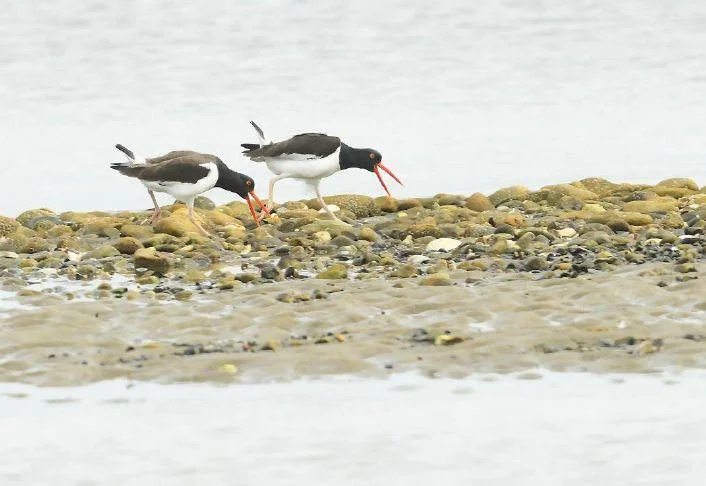
Vulnerable Shorebirds Nesting on Long Island: A Crucial Wildlife Initiative
As spring unfolds on Long Island, it sparks an essential wildlife event: the return of vulnerable shoreline birds to nest along the coast. Species such as the Piping Plover, Least Tern, and American Oystercatcher have begun to establish their nesting grounds, highlighting the importance of conservation efforts in ensuring their survival. With early arrivals documented by dedicated teams, including the Audubon Society, there is renewed optimism for these iconic birds as they face various threats in their natural habitats.
Active monitoring efforts began remarkably early this May with five Piping Plover nests identified across multiple sites. This is part of a broader initiative where volunteers and staff mobilized quickly to protect these nests from predators such as cats and raccoons, which are known to frequent the beaches. The coordination efforts are not limited to Piping Plovers alone; there are also ongoing surveys for over fourteen coastal sites, aimed at safeguarding these avian species during their critical nesting season.
One notable story comes from Matthew Bauer, a seasonal shorebird technician, who shared his experience while monitoring at Jones Beach. "I found my first American Oystercatcher nest at Jones Beach. There’s a lot of beach to cover for just one person, so I was nervous I was missing them!" Matthew said, reflecting the challenges of ensuring each nest is located and protected. His diligent monitoring has already uncovered three eggs in what he hopes will be a successful clutch. This sentiment was echoed by Shelby Casas, the Coastal Program Manager for Audubon in New York, who expressed excitement over these sightings. She noted, "This is a great sign that monitoring and stewardship is making an impact, and the birds are exploring new areas for nesting."
The “Be a Good Egg” program has become a theme for this initiative, pivoting on the need for beachgoers to be aware of their impact on nesting areas. This initiative raises awareness about the need for protecting nests from human disturbance, which could lead to fatal heating or predation. Protecting these vulnerable birds is about the survival of species on the brink; it’s a compelling challenge that reinforces the bond between conservationists and the public in shared spaces.
The successful nesting observed last year at Jones Beach and Tobay Beach—where six chicks hatched from two successful nests—offers hope that these programs are effecting positive change. The collaborative efforts across numerous organizations and volunteers signify a strong commitment to wildlife protection on the island. As nesting season progresses, all eyes will be on the shores to monitor the outcomes for these cherished species.
As we enjoy the natural beauty of our beaches this season, let’s remember that the success of these birds depends on our support and awareness. How can you contribute to ensuring a safe nesting environment for shorebirds in your area? We encourage our readers to share their thoughts and experiences on local wildlife conservation efforts in the comments below!
Active monitoring efforts began remarkably early this May with five Piping Plover nests identified across multiple sites. This is part of a broader initiative where volunteers and staff mobilized quickly to protect these nests from predators such as cats and raccoons, which are known to frequent the beaches. The coordination efforts are not limited to Piping Plovers alone; there are also ongoing surveys for over fourteen coastal sites, aimed at safeguarding these avian species during their critical nesting season.
One notable story comes from Matthew Bauer, a seasonal shorebird technician, who shared his experience while monitoring at Jones Beach. "I found my first American Oystercatcher nest at Jones Beach. There’s a lot of beach to cover for just one person, so I was nervous I was missing them!" Matthew said, reflecting the challenges of ensuring each nest is located and protected. His diligent monitoring has already uncovered three eggs in what he hopes will be a successful clutch. This sentiment was echoed by Shelby Casas, the Coastal Program Manager for Audubon in New York, who expressed excitement over these sightings. She noted, "This is a great sign that monitoring and stewardship is making an impact, and the birds are exploring new areas for nesting."
The “Be a Good Egg” program has become a theme for this initiative, pivoting on the need for beachgoers to be aware of their impact on nesting areas. This initiative raises awareness about the need for protecting nests from human disturbance, which could lead to fatal heating or predation. Protecting these vulnerable birds is about the survival of species on the brink; it’s a compelling challenge that reinforces the bond between conservationists and the public in shared spaces.
The successful nesting observed last year at Jones Beach and Tobay Beach—where six chicks hatched from two successful nests—offers hope that these programs are effecting positive change. The collaborative efforts across numerous organizations and volunteers signify a strong commitment to wildlife protection on the island. As nesting season progresses, all eyes will be on the shores to monitor the outcomes for these cherished species.
As we enjoy the natural beauty of our beaches this season, let’s remember that the success of these birds depends on our support and awareness. How can you contribute to ensuring a safe nesting environment for shorebirds in your area? We encourage our readers to share their thoughts and experiences on local wildlife conservation efforts in the comments below!
Latest
Can you Like
A beloved shorebird couple recently reunited at a private beach along Lake Michigan in Waukegan, completing a remarkable journey for a second consecutive year.
In what ecstatic birders describe as an ...
Howard, WI – The thrill of witnessing the return of an endangered species to local shores is not only a rare joy but also a crucial moment for conservation efforts. The arrival of the piping plovers o...